Sumatran barbus: description, content and breeding
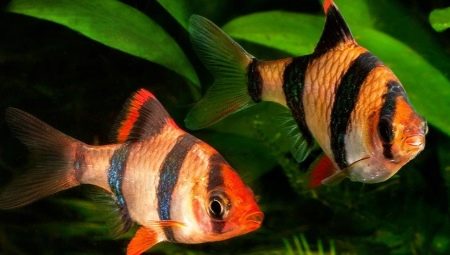
The Sumatran barbus is one of the most common species of aquarium fish and is popular all over the world. These cocky and funny little fish look spectacular in aquariums and are able to revive the life of even the most boring reservoir. They look great both in a flock and alone, are absolutely unpretentious in keeping and have good health.
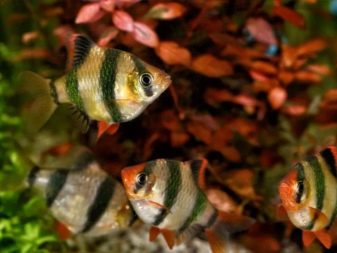
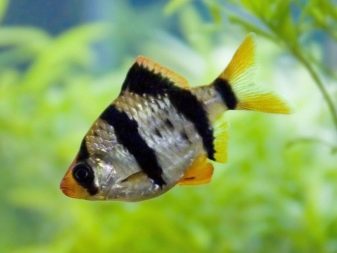
Description
The first mention of the Sumatran barbus dates back to 1855. It was at this time that the famous naturalist-ichthyologist P. Blecker compiled a preliminary description of this species. A full description appeared only in the 30s of the last century. Aquarium enthusiasts immediately liked the new fish and quickly gained popularity in Europe. Somewhat later - in the late 40s - the Sumatran barbus came to the Soviet Union, where it also quickly gained popularity and was very fond of domestic aquarists.
As you might guess from the name, the homeland of the barbus is the island of Sumatra, as well as the reservoirs of Indonesia and Malaysia... In the wild, the fish lives in the fresh rivers of Africa and Southeast Asia, including China, India, Thailand and Ceylon.
An interesting fact is that the size of some natural species reaches one and a half meters, and the aquarium representatives of the species are 4-5 cm long and very rarely grow to 7. Aquarium species are much brighter and more beautiful than their natural counterparts.
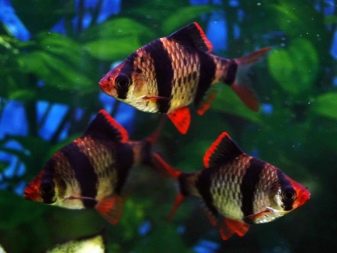

The body of the barbus is rather flat and high, the head has a rounded shape, and the sides are decorated with 4 wide vertical black stripes. They look very impressive on the yellow body of the fish and make it noticeable in the aquarium. The first of the stripes passes through the eye of the barbus, and the last is located at the tail.
The dorsal fins are triangular in shape, painted black, and framed by a bright red border. Lateral and anal fins are red or pinkish; during spawning, they acquire rich, rich colors. Males have a brighter body color and fins in comparison with females.
As for the nature of the Sumatran barbus, then it is a rather peaceful species, which makes it possible to keep it in common aquariums... The best option would be to buy a dozen individuals at once, since a large company of barbs pays no attention to their neighbors and looks very impressive.
However, with sedentary species, it is still not worth settling them, since active barbs begin to attack timid fish and bite off their fins. This is especially true for species with veil fins, past which the barb cannot safely swim.
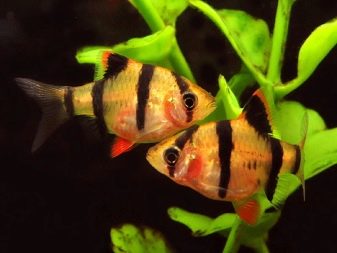
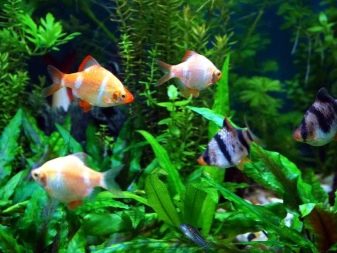
A distinctive feature of the fish is its position during sleep. A sleeping barb hangs head down at a certain angle, which misleads inexperienced aquarists: many of them decide that the fish is dead and begin to take measures to remove it from the aquarium. During wakefulness, barbs prefer to move in flocks and stay in the middle or lower layer of water.
The life expectancy of fish in aquarium conditions is 4 years, and the most common cause of their death is obesity. This is due to the fact that barbs are prone to overeating, which is why they need to be fed strictly according to the norm, avoiding excess and not increasing the frequency of food intake.
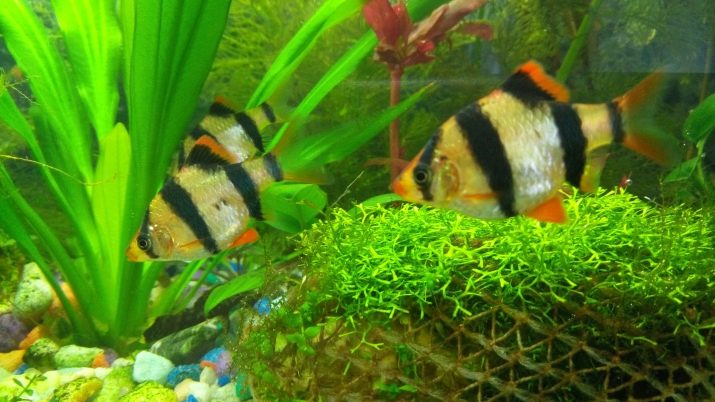
Varieties
Currently, several varieties of the Sumatran barbus are known, which do not differ in anything other than color. Through the efforts of breeders, it was possible to obtain green, scarlet, mossy, glowing barbs, as well as varieties of the black mutant and albino. As a result of selection work, specimens appeared that only vaguely resemble the original, but possess excellent decorative properties and are in high demand.
The change in the base color of the fish was obtained in different ways. This is the ultraviolet effect on newly laid eggs, and a radical change in temperature, hardness and hydrogen level in the aquarium liquid. Unfortunately, artificially derived forms are less adapted to external conditions and have not too high immunity. So, some albinos lack gill covers - dense skin formations that cover the gill slits and limit the gill plane.
Almost all artificial species live less and get sick more often.
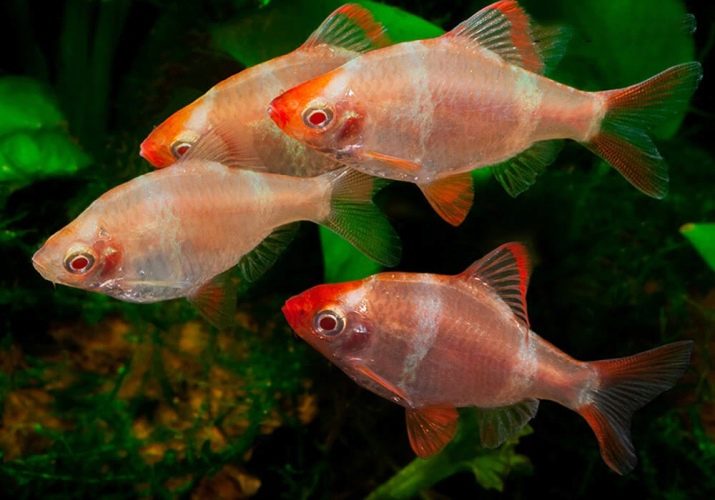
Despite the wide variability of the color of the barbs, the albino and mossy forms are in the greatest demand.
- Albinos have a pink body the eyes are bright red, and the vertical stripes on the body are not black, like the original, but red-pink. Albino species include individuals with a golden color with a black mouth, as well as fish that have a steel-colored body with pinkish-golden stripes. There are albinos with blue stripes, and the males of this species have a noticeable reddening of the head during the spawning period.
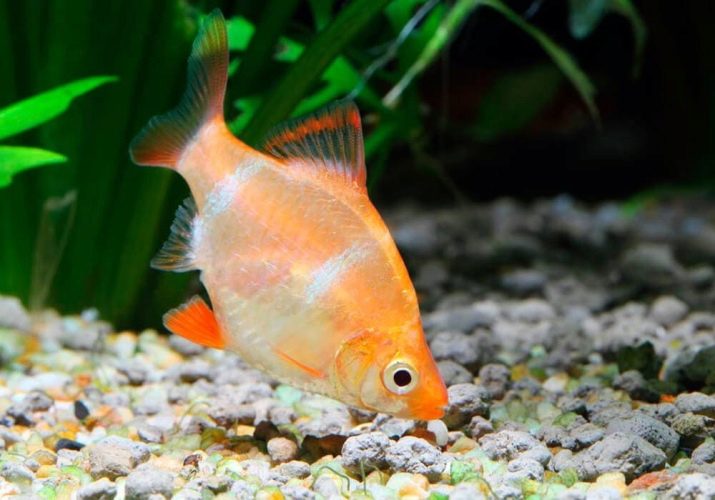
- The mossy barb is a green variety and got its name from the similarity of its body color to the color of forest moss.... At a cursory glance at the mossy barbus, the transverse stripes may not be visible. This is due to the fact that they are all too wide and practically merge with each other, in addition, their shade is very similar to the main body color. A distinctive feature of the mossy barb is its transparent anal fin. All other fins are red or orange.
With age, the brightness of the colors is lost, and by old age the mossy barbs become faded and expressionless.
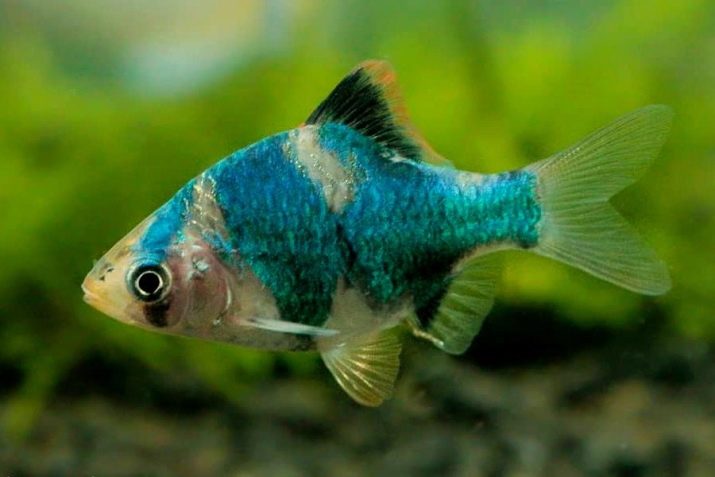
A popular breeding form of the mossy barb is the black mutant barb, bred in Germany. Fish have a green-black body with a blue tint, bordered by orange fins. In this case, the breast, the lower part of the gills and the abdomen are silvery. Such fish look unusually fascinating and, thanks to their unusual color, will never get lost in the aquarium.
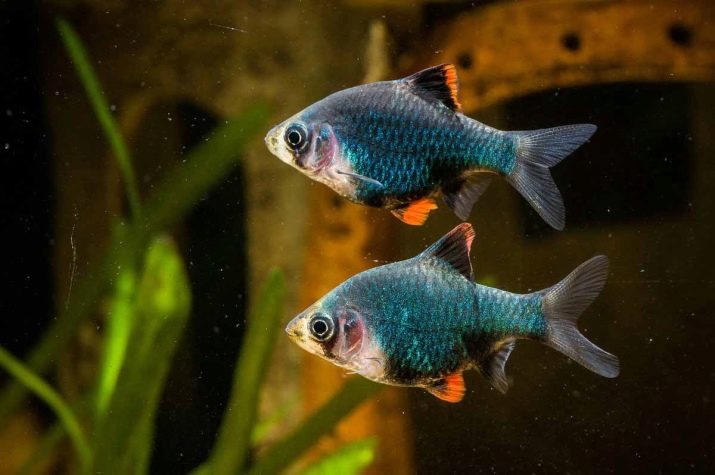
Compatibility
The Sumatran barb gets along well with most of the peace-loving species. However, with their restless games and activity, barbs often tire the calmer inhabitants of the aquarium, so it is not worth keeping them with too inert fish. Ideal neighbors will be tetras, zebrafish, neons, metinnis, kalamoicht, thorns, all varieties of catfish, polypters, moths and parrots.
Guppies can also be lodged with barbs, but only those species in which the tail fin is not veiled in shape, but straight. Otherwise, barbs begin to hunt for a tail fluttering in the water, which significantly annoys the harmless guppy.
The same applies to goldfish, certain types of gourami and ramirezi apistograms - that is, to all those species that have luxurious veil tails. In order to avoid attacks from barbs, it is also not recommended to keep them in the same aquarium with them. In addition, barbs often attack aquarium snails, and also eat fry of too small fish. Therefore, when forming a community, one should not choose especially small species.
It is recommended to buy at least 5-6 barbs: in such a team, the fish will be exclusively occupied with each other.
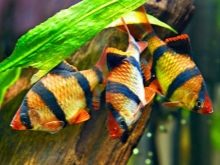
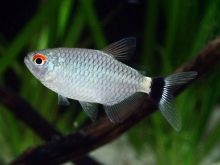
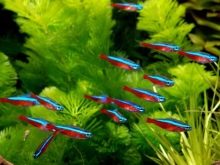
Growing conditions
The Sumatran barb is an easy fish to care for and is well suited for beginners. However, before purchasing young animals, you need to familiarize yourself with some of the features of their maintenance and the rules of care.
- The first step to forming a home community is choosing an aquarium. It should be borne in mind that barbs love to rush around the tank tirelessly, which is why they need sufficient space. Due to this activity, the best option for them would be an elongated rectangular aquarium with a volume of at least 50 liters for every 10 individuals.
- The bottom of the reservoir is filled with coarse sand, having previously calcined it in the oven for half an hour, and thick, lush algae are planted in it, while leaving free areas for swimming. Experienced aquarists recommend using a cabomba or myriophyllum for vegetation. These algae are small-leaved and create an environment in the aquarium that is close to the natural habitat of the species.
- As decorative elements, you can use driftwood or roots of an unusual configuration. or purchase ready-made grottoes, caves and houses. These simple underwater objects contribute to the creation of coziness and effectively decorate the interior of the aquarium. From above, the tank must be closed with glass or a net, otherwise too active barbs will jump out of the aquarium and die on the carpet.
- The next important point is the parameters of the liquid, such as temperature, hardness and acidity. Barbs prefer well-purified soft water from 21 to 26 ° C with an acidity level of 6.5 to 7.5 pH and a hardness not higher than 15 dGh. Every week, the water must be changed, removing up to a quarter of the volume and pouring fresh filtered liquid instead. For the sake of fairness, it should be noted that barbs forgive their owners for minor flaws in care and small deviations from the organoleptic standards of water. They instantly adapt to new conditions and, 5 minutes after starting, they begin to scamper carelessly around the aquarium and arrange their games.
- With regard to aeration of the water in the tank, the Sumatran barbs are among the species for which this parameter is not critically important. Fish are not particularly sensitive to the oxygen content in the water and, in the absence of a compressor, can only be content with a weekly fluid change. However, experienced aquarists are advised to equip the aquarium with all the necessary equipment.
- Lighting also does not play a big role for Sumatran barbs. Natural light in the daytime is quite enough for fish, and they do not need additional lighting. However, for the greatest effect, many aquarists light up their charges, which makes them look even more adorable.
- Filtration in barbs aquarium must be installed without fail. Fish prefer crystal clear water and love to frolic in jets of water.


Feeding rules
Sumatran barbs need to be fed live, dry and frozen foods of animal and vegetable origin. Portions should be strictly measured and in no case overfeed the wards. This is due to the fact that barbs are prone to overeating and, if not stopped in time, can eat a lot. In this regard, a significant part of their diet should be herbal supplements that prevent obesity and protect fish from a variety of associated diseases.
With a lack of plant food, barbs begin to eat plants, independently picking up the elements they need.
The best plant foods are spirulina, spinach, dandelion and nettle pellets. They are pre-poured with boiling water and, after complete softening, fed to the fish.

As live food, barbs should be given bloodworms, tubifex, brine shrimp, cortetra, daphnia and beef heart, previously cut into small pieces. As for dry ready-made food, the barbus can be fed with any of them, since the fish is absolutely picky and will gladly eat everything that is offered to it. Some aquarists claim that even from bread that is not recommended as fish food, barbs do not refuse and eat it with pleasure.
Barbs are fed twice a day. Feed should be given just enough for the fish to eat it in 5 minutes. Once a week, it is necessary to arrange a fasting day, not giving your wards any food at all. This will reduce the risk of obesity and related diseases.
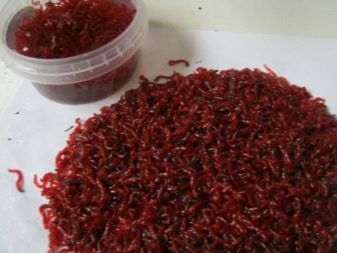
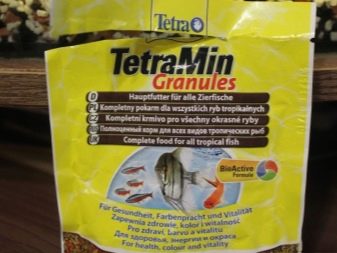
Sex differences and reproduction
Distinguishing the female of the Sumatran barbus from the male is quite simple. This can be done as early as 3 months of age. The differences are especially noticeable when the barbs are in groups of 10 or more individuals.
So, females are noticeably larger than males and less brightly colored. By about 6 months, their belly begins to round and the area around the anus begins to swell. Both traits signal the onset of maturity and the female's readiness to reproduce.
Males during this period become even brighter and more beautiful, they begin to play a lot with each other and persistently look after females. In the most active males, the zone near the mouth begins to literally “burn with red fire”, which makes it possible to determine and select the most suitable individuals for spawning. Another difference is the color and shape of the fins. If in males the anal fin has a straight shape and departs from the body at an obtuse angle, then in females it grows almost vertically and has a wider lower part.
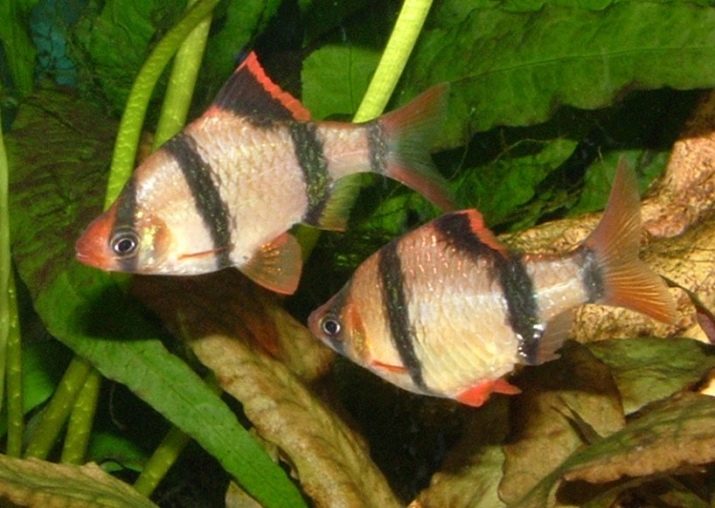
Sumatran barbs are ready for the appearance of offspring, depending on the conditions of detention and the variety, already by 5-9 months of age. They are the best suited for novice aquarists for the first experience in breeding, due to the high fertility and good survival rate of fry.
- Start breeding barbs follows with the choice of parental individuals, taking into account the intensity of the color of the male and the thickness of the abdomen of the female.
- Preliminary seating of a couple in different containers is optional, so both parents can be in the same container. Their diet should include as many protein-rich foods as possible, such as bloodworms and tubifex.
- A container with a volume of 15 to 20 liters is used as a spawning grounds. a height of no more than 25 cm, and instead of sand, a synthetic washcloth, Thai fern or Javanese moss are placed on its bottom. A separator mesh must be laid on top of the substrate, which prevents the parents from devouring the eggs.
- A compressor and a heater are certainly installed in the tank, no filter is required.
- The female is placed first in the spawning grounds, and after a couple of days a male is added to her.
- During the day, the temperature of the liquid in the tank is maintained at 22-24 ° C, and by the evening on the eve of the planned spawning they are raised to 26-28 ° C. As a stimulant for early spawning, distilled water is added to the aquarium in an amount of 20-30% of the total volume. It is not recommended to feed the parents this evening. With the first rays of the morning sun, the female starts spawning, which lasts from 2 to 3 hours and allows to get up to 600 eggs.
- As soon as spawning comes to an end, both parents are caught, and some of the water is carefully replaced with fresh water. It is not recommended to plant parents immediately in a common aquarium. Usually they are launched into a small otzadnik, where, within a couple of days, the water temperature is gradually lowered to the temperature in the general aquarium.
- After the parental couple is separated, methylene blue is added to the spawning grounds, which prevents the fungus from damaging the eggs. The drug is added in small portions until the water acquires a faint blue tint. An overdose of this substance is unacceptable and can cause the death of eggs.
- Further, the water level in the spawning box is lowered to 10 cm and aeration is increased. Then the separator mesh is taken out, having previously shaken off all the eggs from it.
- The spawn is well covered with a dark cloth and removed to a shaded place. This must be done so that ultraviolet rays do not fall on the eggs.
- 12 hours after spawning, unfertilized white caviar is removed with a pipette. If this is not done, then there is a high probability of the death of live eggs.
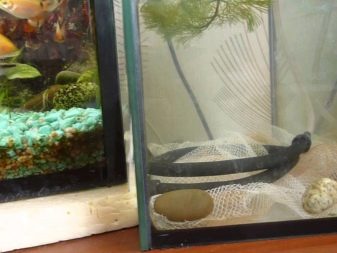
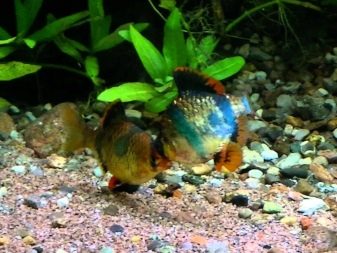
After 2 days, larvae begin to form from the eggs, which feed from their yolk sac for 3 days. On the 5th day, full-fledged fry develop from the larvae, which begin to actively swim in the spawning grounds and eat live dust and ciliates. Feeding the offspring should be carried out every 4 hours, and the main emphasis should be on live, protein-rich food. Otherwise, the young will grow up weak and underdeveloped, and many of the fry will not be suitable for further reproduction at all.
During the first week of fry life, the tank should be illuminated around the clock. Then the backlight should be turned on only during the daytime when there is insufficient natural light. At the end of the first month of life, small barbs display all the morphological features of the species characteristic of adults.
During the warm season, the females of the Sumatran barbus are able to "go" several times to spawn and give birth to numerous offspring.
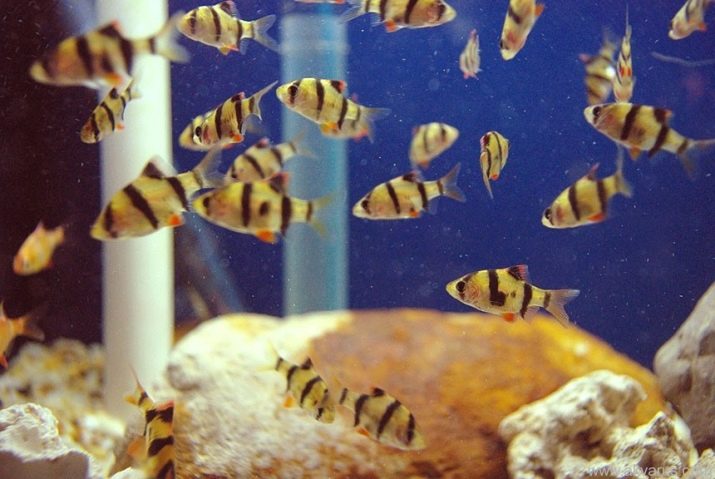
For more information about the features of these fish, see the next video.








